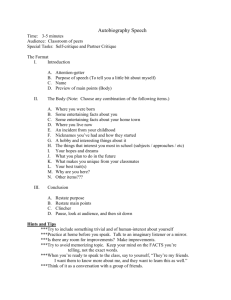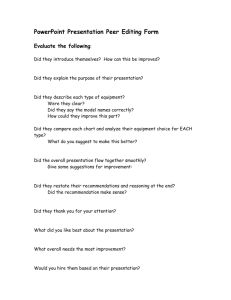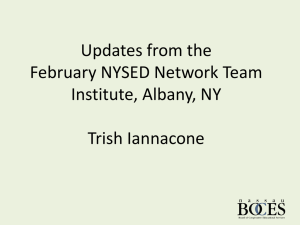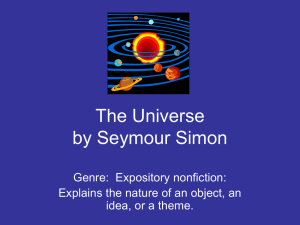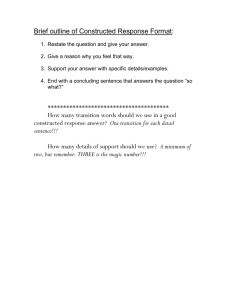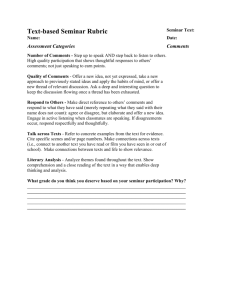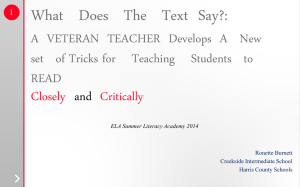R.A.T.T. Power Point Presentation
advertisement
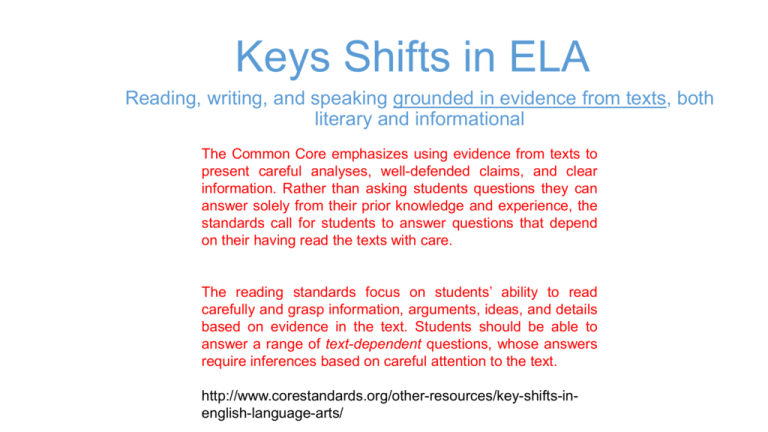
Keys Shifts in ELA Reading, writing, and speaking grounded in evidence from texts, both literary and informational The Common Core emphasizes using evidence from texts to present careful analyses, well-defended claims, and clear information. Rather than asking students questions they can answer solely from their prior knowledge and experience, the standards call for students to answer questions that depend on their having read the texts with care. The reading standards focus on students’ ability to read carefully and grasp information, arguments, ideas, and details based on evidence in the text. Students should be able to answer a range of text-dependent questions, whose answers require inferences based on careful attention to the text. http://www.corestandards.org/other-resources/key-shifts-inenglish-language-arts/ Pedagogical Shifts in ELA Demanded by the Common Core State Standards Shift 1 Balancing Informational & Literary Text • Students read a true balance of informational and literary texts. Shift 2 Knowledge in the Disciplines • Students build knowledge about the world (domains/ content areas) through TEXT rather than the teacher or activities Shift 3 Staircase of Complexity • Students read the central, grade appropriate text around which instruction is centered. Teachers are patient, create more time and space and support in the curriculum for close reading. Shift 4 Text-based Answers • Students engage in rich and rigorous evidence based conversations about text. Shift 5 Writing from Sources • Writing emphasizes use of evidence from sources to inform or make an argument. Shift 6 Academic Vocabulary • Students constantly build the transferable vocabulary they need to access grade level complex texts. This can be done effectively by spiraling like content in increasingly complex texts. Writing Strategy •R.A.T.T. •R = Restate the Question •A = Answer the Question •T = Text-based Detail •T = Text-based Detail Restate, Answer, Text Evidence, Text Evidence Text-Based Evidence Most Common Core reading tasks ask students to use "text-based evidence" to support their answers. Text-based evidence can either be paraphrased or directly quoted from the text. If it is directly quoted, it needs to be enclosed in quotation marks and introduced by the student's own words. Some tips for using text-based evidence appropriately are: • Understand the language of the question and what it is asking of you. • Restate the question. • Answer first, then look for text evidence and more text evidence to support your answer. • Paraphrase or use a direct quote. • Use evidence statements such as; for example, the author states, it states on page, according to the text, within the reading I found. • Add your voice. • What did you think about it? • Use phrases like: "I think", "I believe", "the author was right", "the society was wrong“. Adapted from - http://coe.k12.wa.us/Page/156 Examples of R.A.T.T. Writing Strategy HITCHHIKERS 31 Many scientists are now concerned that dust storms are also carrying harmful chemical pollutants. In many areas around deserts, farmers sprinkle artificial herbicides and pesticides onto the soil. When that soil blows skyward, these dangerous chemicals can hitch a ride too. 35 By examining Asian dust that has been dumped on the U.S., scientists have also discovered that soot and other air pollutants can latch on to the particles. In New England, scientists analyzed the material left behind after dust from a Gobi Desert storm passed by in 2001. They discovered that the airborne particles contained the toxic gas carbon monoxide—probably emitted by a power plant in Asia. “As a dust storm generated in Asia 40 passes over urban areas, polluted air gets mixed with the dust, and it all gets transported at the same time,” explains Robert Talbot, an atmospheric chemist at the University of New Hampshire. *Passage taken from the NYS 2014 Common Core ELA Grade 6 Exam Explain why the author uses the term “Hitchhikers” as the title for lines 31 through 42. Use two details from the article to support your response. R- The author uses the term “Hitchhikers” as the title for lines 31 through 42 A- because air pollutants and dangerous chemicals are latching on to sand particles or getting a ride, similar to what a hitchhiker does and traveling with the sand as it is blown around. T- According to the article, In New England, scientists analyzed the material left behind after dust from a Gobi Desert storm passed by in 2001. They discovered that the airborne particles contained the toxic gas carbon monoxide—probably emitted by a power plant in Asia. T- Scientist concluded that as a dust storm that began over Asia then passes over urban areas, polluted air gets mixed in with the dust, all getting transported together at the same time. Therefore, the term “hitchhiker” accurately describes this process. *Question taken from the NYS 2014 Common Core ELA Grade 6 Exam Reading Strategy •R.A.T.T. •R = Read •A = Around •T = The •T = Text Read Around The Text https://sites.google.com/site/wsurll7990/home/the-middleschool-high-five/strategy-1-read-around-text Examples of R.A.T.T. Reading Strategy *Taken from NYS 2015 Common Core Math Exam Grade 8 • Ms. Donaldson earns $18.80 per hour for the first 40 hours she works in a week. She • Earns 1 ½ times that amount per hour for each hour beyond 40 hours in a week. Last • week Ms. Donaldson worked 45.5 hours. How much money did she earn? • Show your work. • • • R -I need to find how much $ she earned A – 18.80 x 40 = $752, 18.80 x 1.5 = $28.80, 28.80 x 5.5 = $155.10, $752 + 155.10 = $907.10 T - 18.80 per hour for the first 40 hours • T - Earns 1 ½ times that amount per hour for each hour beyond 40 hours • Answer $ _$907.10___________________________ • A health insurance payment of $34.55 was deducted from Ms. Donaldson’s earnings for • the week. After the insurance deduction, payroll taxes equal to 28% of the balance • were deducted. What was the amount that Ms. Donaldson received? • Show your work. • R – I need to find out how much money she received in her check • A - $907.10 – 34.55 = $872.55, 872.55 x 0.28 = $244.31, $872.55 – 244.31 = $628.24 • T - $34.55 was deducted • T - payroll taxes equal to 28% of the balance were deducted. • Answer $ __$628.44_______________________________ *Taken from NYS 2015 Common Core Math Exam Grade 8 What does R.A.T.T. Look Like in First Grade? R.A.T.T. in Reading Read Around The Text Use the pictures to help and support you. R.A.T. in Writing Changed to one T (modifying for first grade) Restate the question Answer the question using details from the text. This is where the student looked back into the story (text) to answer the questions using R.A.T. R.A.T.T. in Math There are 9 red birds and 6 blue birds in a tree. How many birds are in the tree? Student attended to the text based details. Restate the question and show the answer. What Could R.A.T.T. Look Like in the High School? The University of the State of New York REGENTS HIGH SCHOOL EXAMINATION GLOBAL HISTORY AND GEOGRAPHY Wednesday, June 13, 2012 — 9:15 a.m. to 12:15 p.m., only R.A.T.T. as a Writing Strategy- in High School • R.A.T.T.- Can be used both for the intro para. & the essay itself. • R = Reword the Question/Historical Context (intro para.) • A = Answer the question; “What is my point?” (intro para.) • T = Task number 1- Typically S.S. Regents have two tasks in essays. (2nd paragraph of essay) • T = Task number 2 (3rd paragraph of essay) • C= Conclusion(R.A.T.T. with Cheese for essays) (last para.) R.A.T.T. as a Writing Strategy- in High School (Continued) •R = Reword the Question/Historical Context Global History and Geography •A = Answer the question; “What is my point?” Content-Specific Rubric •T = Task number 1- Typically S.S. Regents have two tasks in essays. Thematic Essay—June 2012 Theme: Human and Physical Geography •T = Task number 2 •U = Underline Throughout history, geographic features have influenced the development of civilizations and regions. Geographic features have both promoted and limited interactions with other civilizations and regions. Task: Select two different geographic features and for each • Discuss how this geographic feature influenced the development of a specific civilization or region • Discuss how this geographic feature promoted and/or limited the interaction of this civilization or region with another civilization or region Restate, Answer, Text, Underline- (R.A.T.U.) Document -Based Questions Both the the U.S. History and The Global Studies Regents, Part III has a series of Document-Based Questions, reading tasks ask students to use the doumcent to answer the questions. A modification of R.A.T.T. for high school use could look like this: •Understand the language of the question and what it is asking of you. •Restate/Reread the question. •Answer, Scan the text for your Answer. •Underline key words in the question to help focus what is actually being asked and underline your answer in the text. Adapted from - http://coe.k12.wa.us/Page/156 Reading Strategy •R.A.T.T. •R = Read •A = Around •T = The •T = Text Read Around The Text Why does Thomas Malthus believe that a perfect society is impossible? What happened to the population of London during and after Malthus’ lifetime? Has population remained a critical issue throughout modern history? Explain your answer. https://sites.google.com/site/wsurll7990/hom e/the-middle-school-high-five/strategy-1read-around-text T- text based T- text based R R – Restate – I have to prove ∆ACD is congruent to ∆BDC A - answer 38 This is ONE possible solution. Given: Prove: 1. 1. Given 2. 2. 3. 3. 4. 4. 5. 5. 6. 6. T – Text based Parallel lines intercept congruent arcs. Reflexive property. Inscribed angles intercepting congruent arcs are congruent. Inscribed angles intercepting the same arc are congruent. AAS Thoughts????

